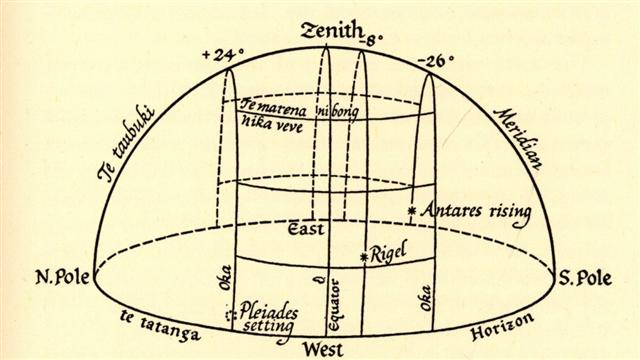1. South of the equator everything is upside down. For us, who are living north of the equator, the idea to read a rongorongo tablet from bottom up appears peculiar to say the least. Yet, considering how everything is beginning from the bottom and growing up as time goes by, before the inevitable decay sets in and gradually returns it all to dust again, it is our own custom of writing which is strange. The beginning of the front side of the G text is not beginning at the top end, it is beginning at the bottom end. It is easy to be led astray and to think otherwise because my own text is running like water downwards - even when I am showing sequences of glyphs. There are structures in our minds which govern our perceptions and then our actions. The Gilbertese have their beginning with Antares rising and their end with the Pleiades setting:
This is probably also how we ought to read my list of stars, viz. from bottom up:
Sun will reach Antares after having first visited Spica, Arcturus, and Toliman. But when the stars are rising in the east they follow the opposite order which e.g. puts Procyon before Sirius. Antares will therefore be number 1 of all my 15 stars above. I have redmarked the Tahitian star pillars and Ana-mua is number 1 on that list. Sun moves from top down and in that order Antares will be number 15. This is the view which we in our western culture are accustomed to. Moon moves in the other direction, from bottom up like all living things on earth, and according to the Polynesian view the stars appear in the night and they can be seen to follow the rule of Moon, first rising and then descending. The declination of stars are measured from the equator and towards the poles. Rigel is located at 8º S and one of the 3 star signs used in the Gilbertese sky. The distance from Antares to Rigel is 26 - 8 = 18º. The distance from Rigel to the Pleiades is 24 + 8 = 32º. These measures are probably part of the structure of the Polynesian mind. The stars are in the night and by cause of the 2 faces of Moon (who rules in the night) we should count 2 * 18 = 36 respectively 2 * 32 = 64. Rigel is not among the Tahitian star pillars, probably because they are Moon stars, such which are used for 'longitude' measurements, such which define time. Neither is Alcyone (in Tauono, the Pleiades) a sign for measuring time. Instead Aldebaran has been chosen. The reason is obvious: Aldebaran forms a pair with Antares:
This pair of prominent stars can be used to identify opposite corners in the sky roof. They are at the beginning of the Tahitian star pillar list because they are important for telling the time of the year, they divide the year in half. 182 = 364 / 2 = 7 * 26. |
|||||||||||||||||||||||||||||||||||||||||||||||||||||||||||||
